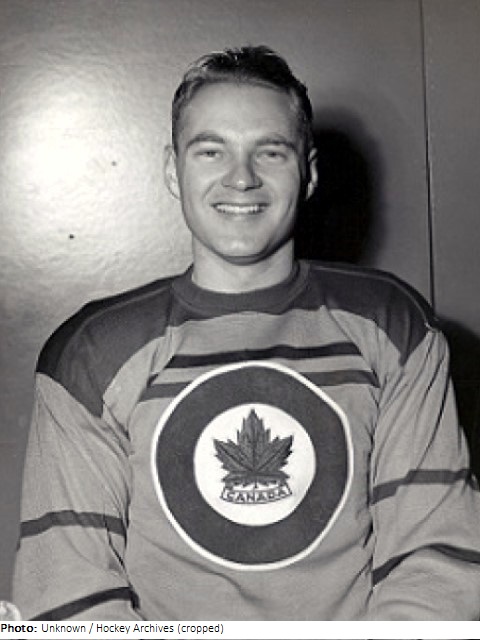George Mara began playing ice hockey at Upper Canada College in 1937, eventually captaining the school’s team, and joined the Toronto Marlboros junior hockey team after a brief stint with the Toronto Telegram of the Toronto Hockey League (TOHL) in 1941. He graduated in 1942 and, after a game with the TOHL’s Toronto Tip Top Tailors, finished the season with the Senior Ontario Hockey League’s Toronto Navy. He served as a Lieutenant in the Royal Canadian Navy during World War II, after declining an offer to join the Detroit Red Wings, and was also affiliated with the Halifax Navy hockey team, the Toronto Staffords, and the University of Toronto Varsity Blues at various times through 1947. In 1946 he signed up to try out with the NHL’s New York Rangers, but never played a game. He later tried out for the Toronto Maple Leafs, but was deemed to be not “blue-collar” enough by the team’s owner Conn Smythe, as his family was well-off due to their liquor firm. After this rejection, his began to work with the family business and nearly turned down the RCAF Flyers’ invitation to join their delegation to the 1948 Winter Olympics as representatives of Canada. At the tournament, which Canada won, he captained the team, played in eight games, and scored seventeen goals. During this time he also played two games with the TOHL’s Toronto Barkers. His final season was 1948-1949, when he played seven games with the Montreal Royals of the Quebec Senior Hockey League.
Mara spent the rest of life involved in his two passions, business and hockey. He was an executive on the board for the Maple Leaf Gardens from 1957-1969, including a brief term in the final year as President. He sold his liquor firm in the early 1970s and moved to the Jannock Corporation, a holding company, where he acted as vice-chairman. Known also for his philanthropic efforts, he helped establish, and until 1988 chair, the Olympic Trust of Canada, which helped raise funds for the Canadian Olympic Committee to support Olympic athletes. For his services with this foundation, he was made a member of the Order of Canada in 1976. In addition, he sat on the boards of Wellesley Hospital, the Ontario Society for Crippled Children, Confederation Life, and the Ontario division of the Canadian Cancer Society. He died in August 2006 as a result of complications from heart surgery. He was made a member of Canada’s Sports Hall of Fame in 1993, awarded the Canadian Olympic Order in 1994 and, as a member of his gold medal-winning Olympic team, he was inducted into the Canadian Olympic Hall of Fame in 2008.

 Canada
Canada CAN
CAN CAN
CAN